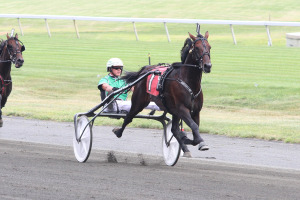Yonkers Raceway to revive International Trot
In the starter”™s office, a mobile office trailer just outside the rail on the clubhouse turn at Yonkers Raceway, photos of the grand old days of harness racing adorn the walls.
“You wanna see how it changed?” asked Andy Toscano, the track”™s starter. He pointed at a photo of a packed grandstand at the now-closed Roosevelt Raceway on Long Island in the mid-1970s. “Right here. This is how it changed, from that to a handful of people.”
While harness racing”™s share of the North American gaming market has shrunk sharply over the past 40 years, Yonkers Raceway has survived. Off-track betting parlors, the legalization of casino gambling in Atlantic City and state lotteries all made their dents, but the legalization of video slot parlors at racetracks in New York state poured money into harness racing.

But now, the half-mile oval will also be simulcasting races to Europe starting Nov. 9. And due to that influx of slot money, Yonkers Raceway has announced plans to revive the International Trot, which will pit the best harness horses and drivers from North America against trotters from Europe.
“We brought up that we”™d like to try simulcasting races to France,” said Bob Galterio, chief operating officer of Empire City Casino at Yonkers Raceway.
Galterio said the genesis of the deal to simulcast racing to Europe came from Alex Dadoyan, the executive director of the Standardbred Owners Association of New York. Dadoyan, who previously worked at Meadowlands Racetrack, had worked with French company Pari Mutuel Urbain to simulcast The Hambletonian and Breeders Crown races to Europe.
“The PMU started taking just one race, The Hambletonian, then a few more races off individual cards, but it was always a one-day thing,” Dadoyan told the Business Journal. “This is novel because it is a weekly feature.”
From Nov. 9 through Dec. 14, Yonkers will simulcast the first five races on a 12-race card to France, with post time for the first race at 11:10 a.m. Those five races will be run at a trot and at a longer distance ”“ a mile and a quarter as opposed to the usual mile ”“ and feature larger fields of 10 or 12 horses, compared with the usual Yonkers field size of eight, Galterio said.
As with the races Yonkers Raceway simulcasts to other tracks and casinos in North America, the track will get revenue from European wagering on the races. Yonkers Raceway”™s cut will be about 3 percent of the sums wagered.
“The number we”™ve been estimating is about 1 million euros. Of course, we haven”™t done this before, but that”™s the number that the PMU tells us would be reasonable,” Dadoyan said.
The average amount of money wagered on a regular race card at Yonkers is $750,245, according to information provided by track spokesman Frank Drucker. Simulcasting is one chunk of the revenue that keeps harness racing alive at Yonkers Raceway. But the revenue from Empire City Casino”™s 5,300 slot machines is the biggest chunk, and without it, the track likely would have been sold and redeveloped.
While the crowds on the apron and in the stands watching the races today are a fraction of what they were in the track”™s heyday, the quality of the racing has improved of late, largely due to the influx of slot money. And now, because of that slot money, the International Trot is set to return to Yonkers Raceway in 2015 after a 20-year hiatus.
The race will pit the best trotters from North America against the best trotters from Europe in a mile-and-a-quarter race for a purse that could be as much as $1 million.
“That was always the historical appeal when that race was in its prime,” Dadoyan said. A staple of the Roosevelt Raceway schedule from 1959 until that track closed in 1988, the International Trot moved to Yonkers for the 1989 season. But funding for the race dried up and it was taken off the schedule in 1996.
“The International Trot is a great event,” Galterio said. “Back then, it was expensive for us, because we had to pay the expenses to bring in the horses, drivers, trainers and grooms from Europe.”
With the bigger purse, it”™s expected that horse owners and trainers will pay their own way to come to compete in the International Trot, the same way they have for the nightly race cards as purses have gotten bigger the past few years. Galterio explained that a percentage of the overall purse money is allotted for stakes races each year, and if it isn”™t used, it”™s rolled over into the daily racing purses for the next year.
“We”™ve been able to get a lot of money for purses now that we have slots,” Galterio said. “In 2005, we had about $15 million in purses, and compare that to about $60 million this year. That was one of the goals of allowing slots at racetracks, and it”™s been very successful.”
With close to 250 days of racing each year, Galterio admitted that it can be difficult to get people excited about the comparatively smaller purses that drivers and horses run for each day. For the European simulcasts, the first 200 fans will get $10 in free bets and breakfast will be served from 10 a.m. until noon.
For next year”™s International Trot, Galterio said he thinks no gimmicks will be required.
“We had a great crowd last Saturday for the International Trot Preview, the Messenger Stakes and the Yonkers Trot,” Galterio said, referring to the three big races on the Oct. 25 card. “You can”™t make a big deal about racing every day, but we can pick out some special occasions like the International Trot to get people to come out.”